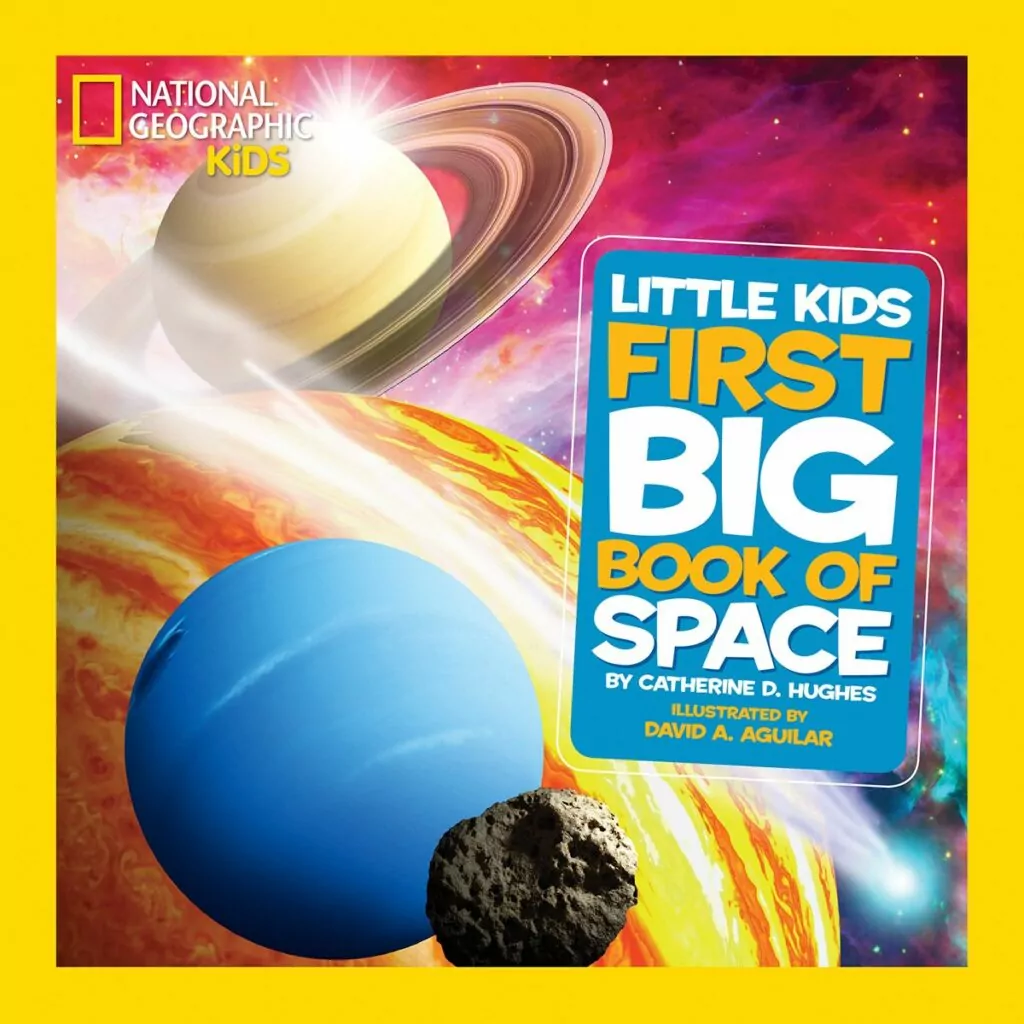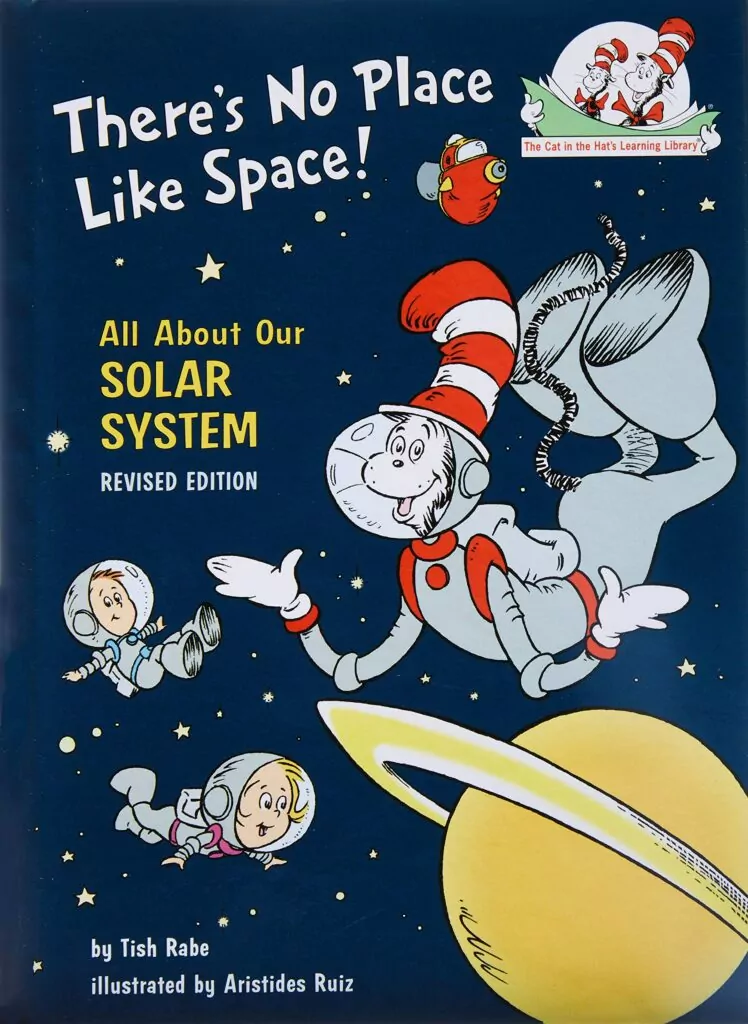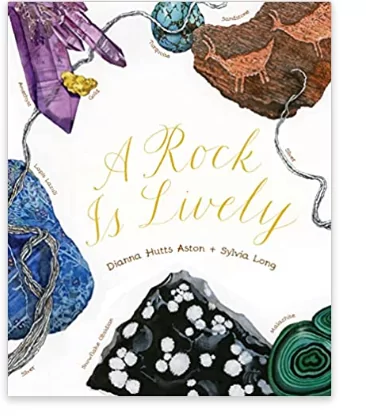
In a world that’s rapidly evolving with technological advances and scientific discoveries, fostering a sense of wonder and curiosity about science in young minds has never been more crucial. Science books for kids play a pivotal role in this journey, transforming complex concepts into engaging narratives that captivate and educate. These books open doors to endless possibilities, encouraging kids to question, explore, and understand the world around them. From the mysteries of outer space to the intricacies of human anatomy, science books lay the foundation for a lifelong pursuit of knowledge and innovation.
Science Books for kids
In this curated list, we explore a variety of books that are designed to ignite the spark of scientific inquiry in children. Each title, carefully selected, aims not only to inform but also to inspire young readers to dream big and reach for the stars.
1. National Geographic Little Kids First Big Book of Space, by Catherine Hughes
National Geographic Little Kids First Big Book of Space, by Catherine Hughes is an introductory guide to the wonders of space for young children. With bright illustrations and simple text, this book is ideal for beginning readers or for adults to read aloud. Chapters cover the Earth, moon, and sun; planets; other objects in our solar system like dwarf planets, comets, and asteroid belts; the universe, Milky Way, stars, galaxies, and black holes; and space exploration including humans on the moon, spaceships, and the International Space Station.
2. There’s No Place Like Space: All About Our Solar System, by Tish Rabe
There’s No Place Like Space: All About Our Solar System, by Tish Rabe, is a fun and informative book that explores the mysteries of the universe. Readers will learn about different planets, such as Mercury, Venus, Earth and Mars, as well as their moons. They’ll also learn about asteroids and comets, plus the different types of stars such as red giants and white dwarfs.
3. How Does My Body Work?, by Sara LaFleur MD
The Human Body Book for Kids by Sara LaFleur MD provides an engaging and interactive look at the human anatomy, designed to help curious kids learn about their bodies and how they function. With more than 40 STEAM experiments and activities, full-color illustrations and photographs that highlight cells, tissues, organs and body systems, this book is jam-packed with exciting science, weird facts, and fun activities. Kids can create their own models, learn to identify organs and body systems, participate in edible experiments, and show off their STEAM skills to family and friends.
4. Once Upon a Star: A Poetic Journey Through Space, by James Carter
Once Upon a Star: A Poetic Journey Through Space, by James Carter is an engaging and captivating exploration of our solar system and universe. With vivid illustrations depicting the space race era, this hip and fun book is sure to keep young readers engaged and learning about science topics in an inviting, memorable way. From the Big Bang to the formation of planets and life on Earth, this book is sure to be a stimulating read for budding scientists.
5. Amazing Science Activities for Children, by Dr. David P. Mitchell
Amazing Science Activities for Children: 50 illustrated and easy-to-follow STEM home experiments, projects, codes, ciphers and facts is a great addition to any home. With step-by-step instructions, your child can explore science in a stimulating and exciting way while developing their problem-solving skills, creativity, and critical thinking. They’ll explore topics such as geology, biology, physics, chemistry and mathematics with the help of our “Little Scientists”!
Related: 12 Best Audiobooks for kids
6. Human Body Homeschool: Skin: human body for kids, by A.D. Largie
Human Body Homeschool: Skin: human body for kids, by A.D. Largie is a Level One I Can Read Kids book that introduces children to the basics of human biology in a fun, engaging way. It focuses on skin, teaching children about its different layers, functions, and its importance in keeping our bodies healthy. With easy to read text and large full-color illustrations, this book is perfect for beginner readers looking to learn more about their bodies. Children will also discover different types of skin conditions, such as eczema and psoriasis, and how they are treated.
7. How We Got to Now, by Steven Johnson
How We Got to Now: Six Innovations That Made the Modern World by Steven Johnson explores the history of innovation over centuries, tracing how certain facets of modern life came to be and the unintended consequences that followed. Johnson examines unexpected connections between seemingly unrelated fields, showing how things such as air-conditioning, pendulum clocks, and clean water have contributed to the development of the modern world.
8. The Simple Science Activity Book, by Jane Bull
The Simple Science Activity Book: 20 Things to Make and Do at Home to Learn About Science, by Jane Bull is a hands-on crafty adventure that engages and educates children. When they actively participate in the activities, they will gain a deeper understanding of the scientific concepts behind them, making learning easier and more memorable. Every project includes an explanation of the science behind it, building a strong foundation for future scientific pursuits.
9. Ask A Scientist!, by Robert Winston
Ask A Scientist: Professor Robert Winston Answers 100 Big Questions from Kids Around the World!, by Robert Winston is a fun and engaging educational book for kids. It covers the main science topics from chemistry, physics and the human body, to all about the Earth, space, and the science of nature. Each question is illustrated, making the book interesting and interactive for kids as they explore the world of science.
10. Fairy Science, by Ashley Spires
Fairy Science Hardcover , by Ashley Spires, is a charming story about Esther, a fairy who is different from all the other fairies in Pixieville. Esther believes in science rather than magic and uses her scientific knowledge to help solve the problem of why a forest tree has stopped growing. With whimsical illustrations, this book is sure to delight readers of all ages.
11. Diary of a Young Naturalist, by Dara McAnulty
Diary of a Young Naturalist is an inspiring and moving debut novel by Dara McAnulty, which chronicles the turning of a year in his Northern Ireland home patch. Through vivid and evocative entries, readers are taken on a journey of discovery as they explore the beauty of nature, the complexities of living with autism, and Dara’s inspiring example as a young naturalist and conservationist.
12. Planet Earth/Inside Out, by Gail Gibbons
Planet Earth/Inside Out, by Gail Gibbons is an informative and engaging nonfiction picture book that introduces young readers to the powerful forces behind the planet’s structure and its changes over time. Through vivid illustrations, detailed diagrams, and easy-to-understand scientific concepts, readers will learn about Earth’s inner workings, from its core to the highest mountain peak.
13. A Rock Is Lively, by Dianna Hutts Aston
A Rock Is Lively, by Dianna Hutts Aston, is a beautiful and informative book about the wonderful world of rocks. The book features stunning photographs and illustrations that bring to life the diverse array of rocks, from sparkling sapphires to mesmerizing moonstone. Children are introduced to facts such as the composition of rocks, how they form, and their fascinating history.
14. National Geographic Little Kids First Big Book of Science, by Kathleen Zoehfeld
National Geographic Little Kids First Big Book of Science, by Kathleen Zoehfeld, is bursting with exciting activities and experiments to inspire young learners to explore the world around them. Kids will learn about forces of motion, plants, animals, rocks and minerals, the solar system, and even explore how a computer works. With delightful illustrations and engaging text, this book will introduce kids to the fundamentals of science in an enjoyable way that encourages exploration and discovery.
15. 5,000 Awesome Facts, by National Kids
5,000 Awesome Facts by National Kids is the perfect gift book for any child who loves to learn exciting new facts. This beautifully designed book is divided into two-page spreads, each of which focuses on a different topic. With vibrant photographs and overflowing with mind-blowing information, this book covers topics such as chocolate, peanut butter, robots, reptiles, sports, spies, and more.
Final thoughts
Through captivating illustrations, engaging narratives, and hands-on activities, these science books invite children to embark on a journey of discovery and learning. They demystify scientific concepts and instill a sense of wonder and respect for the natural world and the technological advancements that shape our daily lives. Whether exploring the far reaches of outer space, unraveling the mysteries of the human body, or understanding the principles that underpin our physical world, these books provide a solid foundation for young learners.





















